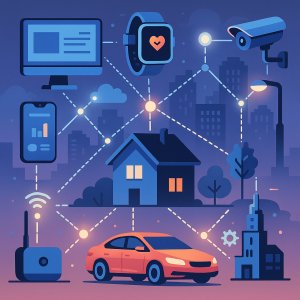 By Dan Gatti–Agentic AI (autonomous, goal-driven AI agents) combined with IoT devices (sensor-rich, connected hardware) creates a powerful growth frontier across multiple industries. The opportunities expand beyond traditional automation into self-directed, adaptive systems that can sense, decide, and act with minimal human intervention.
By Dan Gatti–Agentic AI (autonomous, goal-driven AI agents) combined with IoT devices (sensor-rich, connected hardware) creates a powerful growth frontier across multiple industries. The opportunities expand beyond traditional automation into self-directed, adaptive systems that can sense, decide, and act with minimal human intervention.
Here’s a breakdown of growth applications:
- Smart Infrastructure & Energy
- Grid Optimization: IoT sensors monitor load, weather, and equipment health, while agentic AI autonomously reroutes power, predicts failures, and balances supply/demand in real time.
- Renewables: AI-driven drones + IoT sensors inspect and even repair wind turbines, solar panels, and substations, reducing downtime.
- Smart Cities: Traffic lights, streetlights, and utilities adapt dynamically to usage patterns without manual control.
- Industrial & Manufacturing
- Autonomous Production Lines: Machines equipped with IoT sensors adjust operations based on real-time inputs, with AI agents optimizing throughput and energy efficiency.
- Predictive Maintenance: Instead of just flagging issues, agentic AI orchestrates repairs—ordering parts, dispatching robots, and scheduling downtime automatically.
- Digital Twins: AI agents continuously update virtual models of factories or assets, testing scenarios before applying changes in the real world.
- Healthcare & Wellness
- Remote Patient Monitoring: Wearable IoT devices feed real-time vitals; agentic AI detects anomalies and initiates interventions (e.g., alerting caregivers, scheduling telehealth sessions).
- Smart Hospitals: IoT-enabled beds, infusion pumps, and imaging equipment coordinate with AI agents to reduce bottlenecks and errors.
- Elder Care: Autonomous companions integrate with home IoT to ensure safety (fall detection, medication reminders, climate adjustments).
- Transportation & Logistics
- Autonomous Fleets: Vehicles equipped with IoT sensors collaborate, with agentic AI optimizing routes, fuel use, and maintenance in real time.
- Supply Chain Visibility: IoT-tagged goods tracked from factory to customer; AI agents dynamically reroute shipments during disruptions.
- Air & Drone Systems: AI-driven drones with IoT payloads handle inspections, deliveries, or even emergency responses autonomously.
- Agriculture & Environment
- Precision Agriculture: Soil, water, and crop IoT sensors feed agentic AI that controls irrigation, spraying, and harvesting robots.
- Climate Resilience: AI agents use IoT environmental data to autonomously adjust resource usage and reduce waste.
- Wildlife & Ecosystem Monitoring: IoT devices track biodiversity; agentic AI coordinates conservation actions or hazard responses.
- Security & Defense
- Autonomous Surveillance: IoT cameras and drones powered by agentic AI monitor perimeters and act on detected threats.
- Critical Infrastructure Protection: AI agents coordinate cyber-physical defenses for utilities, data centers, and transportation hubs.
- Disaster Response: Sensor networks plus drones guided by agentic AI assist in search, rescue, and logistics under uncertain conditions.
- Consumer & Smart Living
- Adaptive Smart Homes: IoT appliances learn habits; AI agents anticipate needs (energy use, security, entertainment).
- Personal Health & Fitness: Wearables linked to AI agents dynamically design routines, detect risks, and coordinate with healthcare systems.
- Digital Companions: Always-on agents that interact with IoT devices to act as personal assistants in the physical world.
✅ Growth Outlook:
The biggest drivers will be energy & utilities, healthcare, and industrial automation, where agentic AI turns IoT data into self-executing workflows. Think of it as the shift from “monitor & alert” to “sense, decide, act”.
Dan Gatti is Managing Partner of Innovative Capital Ventures and serves as Executive Director of the Big Data IoT Forum and Executive Director Health Cloud Solutions, a forum for cloud- based solutions. You can reach him at dan.gatti@icventures.net.
